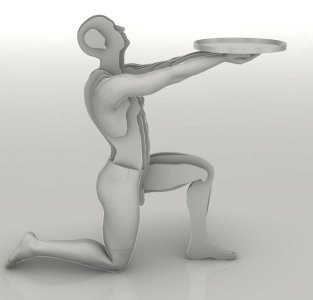Hermes2020
Well-known member
- Messages
- 1,895
In Part 1 I showed the mobile table I made in preparation for the construction of the bird feeder sculpture. Today I will show the design steps and reveal what Windows software I used.
The very first stage was the idea for the piece. Since I love birds so much, I wanted to express my adoration and respect for birds with a kneeling figure offering food to the birds on a a tray. Since it will be installed in a large garden, I thought it should be life size or slightly bigger. It is intended for the same garden where my reclining poolside sculpture is located (https://creativespark.art/threads/reclining-nude-concrete-sculpture.1300/), so part of my concept was to echo the idea of slices in the bird feeder. I also wanted to give it an ancient Greek sculpture flavour, so decided on a 50% mixture of sliced abstract elements with realistic, Greek sculpture inspired parts. I first achieved a pose I liked by manipulating the model of a young man (called Michael) in a software package called Poser until I was happy with the pose. Here is a rendering of the final pose I made.



From Poser the model was exported as an .OBJ 3D model, and then imported into Rhino 3D, my favourite Windows program I use to design my pieces. Rhino is a parametric program, so I can work out scaling and dimensions to a precision of 0.001 mm if needed. For my concrete work, a 1mm tolerance is quite good enough. I will not go into the details here of slicing certain elements into 20mm thick layers, but will explain the steps if anyone wants to attempt something similar. Suffice it to say that Rhino is a powerful package that allows me to do anything I need, like adjusting proportions and designing the technical elements such as the connectors. To keep this part reasonably short, I will describe how I am going to connect the elements together in Part 3.



Well, that is the concept. Let's see whether I have the necessary skill and perseverance to execute it. It is going to be a bit bigger than life size, so I estimate that the mass will be in the region of 90 to 100kg.
The technical details like connections and materials will be discussed in Part 3.
The very first stage was the idea for the piece. Since I love birds so much, I wanted to express my adoration and respect for birds with a kneeling figure offering food to the birds on a a tray. Since it will be installed in a large garden, I thought it should be life size or slightly bigger. It is intended for the same garden where my reclining poolside sculpture is located (https://creativespark.art/threads/reclining-nude-concrete-sculpture.1300/), so part of my concept was to echo the idea of slices in the bird feeder. I also wanted to give it an ancient Greek sculpture flavour, so decided on a 50% mixture of sliced abstract elements with realistic, Greek sculpture inspired parts. I first achieved a pose I liked by manipulating the model of a young man (called Michael) in a software package called Poser until I was happy with the pose. Here is a rendering of the final pose I made.
From Poser the model was exported as an .OBJ 3D model, and then imported into Rhino 3D, my favourite Windows program I use to design my pieces. Rhino is a parametric program, so I can work out scaling and dimensions to a precision of 0.001 mm if needed. For my concrete work, a 1mm tolerance is quite good enough. I will not go into the details here of slicing certain elements into 20mm thick layers, but will explain the steps if anyone wants to attempt something similar. Suffice it to say that Rhino is a powerful package that allows me to do anything I need, like adjusting proportions and designing the technical elements such as the connectors. To keep this part reasonably short, I will describe how I am going to connect the elements together in Part 3.
Well, that is the concept. Let's see whether I have the necessary skill and perseverance to execute it. It is going to be a bit bigger than life size, so I estimate that the mass will be in the region of 90 to 100kg.
The technical details like connections and materials will be discussed in Part 3.
Attachments
Last edited:

